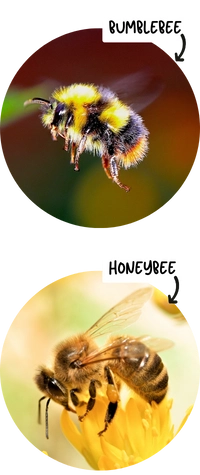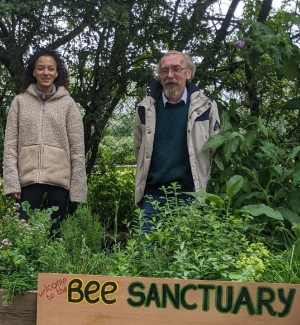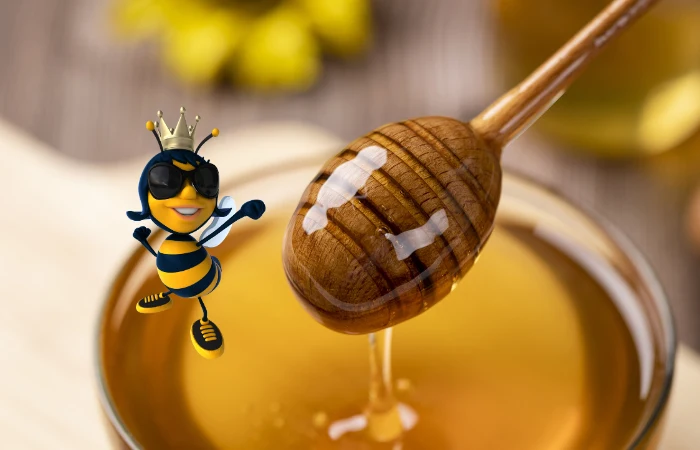‘Bee-washing’ is more than just a buzzword; it’s a misleading marketing ploy with serious environmental repercussions. Think along the lines of ‘greenwashing’ but the main victim on the receiving end are our precious local bees.
As concern for the declining honeybee populations grows, an equally urgent but less known issue is the plight of native bee species. These vital pollinators are facing threats from climate change, pesticides, and habitat loss, yet their struggle often remains overshadowed.
In this article, you’ll discover:
- The true nature of bee-washing and how it impacts both consumers and bees.
- The critical differences between honeybees and native bees, and why both are essential.
- Practical steps you can take to genuinely support bee populations.
Understanding the complexities of bee conservation goes beyond the black-and-white narrative often presented. As we delve into this topic, we aim to shed light on the shades of gray in bee conservation, helping you become a more informed and effective advocate for these crucial pollinators.
The Three Great Threats To Native Bees
Native bees, a cornerstone of our ecological balance, are facing an array of challenges. Their decline is a complex issue, intertwined with various environmental factors. Understanding these threats in detail helps us grasp the gravity of the situation and the urgency of acting. There are three distinct threats to native bees on a global scale. In some regions, there’s also the threat of being burned alive by solar energy panels.
1. Climate Change: Disrupting Delicate Ecosystems
Climate change isn’t just a buzzword; it’s a reality with profound implications for native bees. Rising temperatures and erratic weather patterns are causing shifts in the blooming cycles of plants. This desynchronization between flowering times and bee life cycles means bees often emerge to find that their food sources aren’t available yet or have already disappeared. For instance, a study showed that certain bee species in North America are emerging 10 to 15 days earlier than they did in the late 20th century, missing the peak of floral resources.
Moreover, extreme weather events like droughts and heavy rains can destroy the habitats where these bees live and forage. This environmental stress is a significant factor in their declining populations, affecting their ability to thrive and reproduce.
2. Pesticide Exposure: A Lethal Threat
Pesticides, widely used in agriculture and urban landscaping, pose a direct threat to native bees. Neonicotinoids, a common class of insecticides, have been particularly implicated in bee declines. These chemicals can disorient bees, making it difficult for them to navigate back to their nests, and impact their reproductive abilities. A study published in the Journal of Applied Ecology found that exposure to neonicotinoids reduced the ability of bumblebees to establish new colonies by 85%.
The impact of pesticides isn’t always immediate or lethal, but can have sub-lethal effects that are just as damaging in the long term. For example, some pesticides interfere with bees’ learning and memory processes, crucial for finding food and navigating their environment.
3. Habitat Loss: The Vanishing Grounds
The loss of natural habitats is perhaps the most tangible threat to native bees. As urban areas expand and agricultural practices intensify, the natural landscapes where bees thrive are rapidly diminishing. Meadows, prairies, and forests are replaced with monoculture crops, lawns, and concrete, leaving bees with fewer places to nest and forage. A study by the University of Bristol found that in areas with less floral diversity, bee populations suffered significantly.
The reduction of natural habitats not only affects the availability of food but also impacts the availability of suitable nesting sites. For ground-nesting bees, which make up around 70% of native bee species, the paving over and landscaping of natural ground surfaces is particularly detrimental.
Bee-Washing: A Greenwashed Niche Horror Show
The term ‘bee-washing,’ a play on the more widely known concept of ‘greenwashing,’ represents a deceptive marketing practice where companies capitalize on the public’s concern for bees. This strategy, while seemingly supportive of bee conservation, often misleads consumers and diverts attention from the real issues plaguing bee populations.
‘Bee-washing’ was coined by researchers at York University in 2015, highlighting a growing trend in marketing: using bees as a tool to falsely portray products or practices as environmentally friendly or beneficial to bee populations. This practice is an offshoot of greenwashing, where companies manipulate their image to appear more sustainable or eco-conscious than they truly are.
Honeybees vs. Native Bees: Facts Versus Greenwashed Fiction
In the conversation about bee conservation, we first need to distinguish between honeybees and native bees. While both are important, they play different roles in our ecosystems, and the challenges they face are distinct.
Understanding Honeybees
Honeybees, specifically the European honeybee species, are the most recognized bees worldwide. Known for their honey production and pollination of various crops, they’ve been domesticated and managed by humans for centuries. In 2017, the U.S. alone produced nearly 150 million pounds of honey, a testament to their agricultural importance.
However, European honeybees aren’t native to the Americas.
They were introduced for their pollination services and honey production. As managed pollinators, their populations are sustained through beekeeping practices. While they face threats like disease, habitat loss, and pesticides, global honeybee populations aren’t endangered but are, in fact, increasing, unlike the European bumblebees.
The Role of Native Bees
In contrast, native bees, which encompass over 4,500 species in the U.S., are often overlooked in conservation discussions. These species, including bumblebees, mason bees, and sweat bees, are adapted to local environments, and play a critical role in pollinating wild plants and crops. Unlike honeybees, most native bees don’t produce honey but are efficient pollinators due to their diverse foraging habits and body shapes, which allow them to pollinate a wide range of plants.
The prevalent focus on honeybees in media and marketing often overshadows the plight of native bees. This skewed attention can lead to conservation efforts that primarily benefit honeybees, while native bee species continue to decline in silence. We must broaden the conversation and conservation actions to include the myriad of native bee species that each contribute uniquely to our ecosystems.

How Misleading Marketing on Bee Conservation Efforts Have Hurt Those Very Efforts
The phenomenon of bee-washing, while it may raise general awareness about bees, often leads to misguided and ineffective conservation efforts. Understanding the real impact of such marketing strategies is crucial for redirecting efforts towards more meaningful actions that genuinely benefit bee populations.
Inflating the Importance of Honeybees While Ignoring Native Bees
Bee-washing campaigns typically emphasize the role of honeybees, overshadowing the equally critical, if not more urgent, plight of native bees. This disproportionate focus can mislead the public into believing that efforts like planting non-native wildflowers or setting up bee hotels are comprehensive solutions. While these actions aren’t inherently harmful, they don’t address the specific needs of native bee species, which are crucial for maintaining biodiversity and ecological balance.
One striking example of bee-washing is the 2017 “bring back the bees” campaign by General Mills featuring their mascot, Buzz the Honey Bee. The campaign, while advocating for the planting of wildflowers, oversimplified the complex issue of bee conservation and neglected the importance of native bees and region-specific flora. It also failed to address the need for preserving diverse, native wildflower habitats, instead promoting a one-size-fits-all solution.
While well-intentioned, the distribution of non-region-specific wildflower seeds could potentially introduce invasive plant species, disrupting local ecosystems.
Similarly, the promotion and sale of bee hotels often don’t meet the habitat needs of many native bee species, most of which are solitary and ground-nesting. These products can sometimes cause harm if not properly maintained, as they may facilitate the spread of diseases among bee populations.
Redirecting Conservation Efforts
For conservation efforts to be effective, they need to be informed and targeted. This means understanding the diverse needs of different bee species and addressing the specific threats they face, such as habitat loss, pesticide use, and climate change.
Conservation strategies should be based on scientific research and focus on preserving and restoring native habitats, promoting organic and bee-friendly farming practices, and reducing the use of harmful pesticides.

6 Practical Steps to Support Bee Populations
While the challenges facing bees are daunting, there are numerous actionable steps that individuals and communities can take to make a positive impact. Supporting bee populations goes beyond just being aware of bee-washing; it involves making informed choices and engaging in practices that genuinely benefit bees.
- Planting Native Flowers
One of the most effective ways to support bees is by planting native flowers. These plants provide essential nectar and pollen for native bees and are adapted to the local climate and soil conditions. By creating a garden with a variety of native plants that bloom at different times of the year, you can provide a consistent food source for bees. Research local native plants and consult with gardening groups or local nurseries to find the best options for your area.
- Reducing Pesticide and Insecticide Use
Pesticides and insecticides, while useful for controlling pests, can be harmful to bees. Limiting their use or opting for organic or natural pest control methods can significantly reduce the risks to bee populations. When gardening or managing green spaces, consider integrated pest management (IPM) techniques that focus on long-term prevention of pests through a combination of cultural, biological, and chemical practices that are safe for bees.
- Preserving Natural Habitats
Protecting and restoring natural habitats is crucial for bee conservation. This can involve participating in local conservation efforts, supporting policies that protect natural landscapes, or even simple actions like leaving some areas of your garden wild to provide nesting sites for ground-nesting bees.
- Supporting Organic Agriculture
Organic farming practices, which generally avoid or minimize the use of synthetic pesticides and fertilizers, can be more conducive to bee health. By purchasing organic produce, you can support agricultural practices that are more bee-friendly, encouraging more farmers to adopt these methods.
- Engaging in Citizen Science and Advocacy
Becoming involved in citizen science projects related to bees can help scientists gather valuable data on bee populations and health. Additionally, advocating for policies that support bee conservation, such as those limiting pesticide use or protecting natural habitats, can have a significant impact at a broader level.
- Educating Others
Spread awareness about the importance of bees and the threats they face. Share accurate information (there’s a lot of misinformation, often unintentional, out there) and resources with your community and encourage others to take bee-friendly actions. Education is a powerful tool in combating misinformation and promoting effective conservation strategies.
Conclusion
In this article, we’ve explored the multifaceted issue of ‘bee-washing,’ shedding light on its impact on both bees and consumers. We’ve distinguished between honeybees and native bees, underscoring the importance of each in our ecosystems. Importantly, we’ve identified practical and meaningful actions that can be taken to support these vital pollinators.
Key Takeaways:
More To Discover
- Bee-washing is a misleading marketing tactic that can divert attention from the real issues facing native bee populations.
- Understanding the differences between honeybees and native bees is crucial for effective conservation efforts.
- Practical steps such as planting native flowers, reducing pesticide use with natural alternatives, and supporting organic agriculture can significantly benefit bee populations.
As we conclude, consider this: the journey to supporting bees doesn’t end here. For those eager to delve deeper, engaging in local conservation initiatives or further educating yourself and others about bees can be immensely rewarding.
You might also consider joining or supporting organizations dedicated to bee conservation, such as the Xerces Society, which offers resources and opportunities for active involvement.
The plight of bees is a complex issue, but with informed action and collective effort, we can make a substantial difference.
So, take a step forward, whether it’s transforming your garden into a pollinator haven, advocating for bee-friendly policies, or simply continuing to learn and spread awareness. Every effort counts in the journey to protect these essential creatures that play such a pivotal role in our world.




















